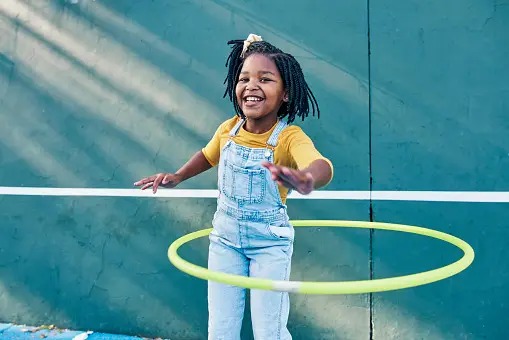When we are children we begin to develop certain skills that are essential for our daily lives. One of them is spatial orientation. Well, in order to promote it, you can work with minors on children’s spatial orientation activities. We show you some of the best examples.
Encouraging children’s spatial orientation is something that can be started when they are still babies, with everyday activities such as stimulating the child with crawling, developing small obstacle courses, etc.
As children grow, activities to work on spatial orientation will increase in complexity, but it is an issue that can continue to be developed until puberty.
What is spatial orientation?
We talk about spatial orientation to define a basic ability to move and locate ourselves within space. This skill is very necessary to perform such common activities as differentiating right from left, reading or writing straight.
Therefore, it is a cognitive ability that is involved in learning to write, read, calculate, and number, and that is essential for locating objects and being able to correctly orient our movements in the space around us. .
Why is it important to work on children’s spatial orientation?
Working on children’s spatial orientation is crucial for their overall development and academic success. Spatial orientation skills involve understanding the position and movement of objects in space. This ability is fundamental for tasks like reading maps, solving mathematical problems, and comprehending geometric concepts.
Children with strong spatial skills often perform better in STEM (science, technology, engineering, and mathematics) subjects. Moreover, spatial awareness contributes to improved motor skills and coordination, benefiting activities such as sports and arts. By fostering spatial orientation early on, educators and parents lay a foundation for cognitive growth, enhancing a child’s ability to navigate the physical and academic world with confidence.
How spatial awareness develops in children
The development of spatial awareness in children improves over time, since to do so they need to establish references that also increase over the years.
The child begins to form the idea of his body schema as he develops the spatial notion. This implies that the minor composes a mental image of his own body in relation to the environment and, based on that representation, knowledge of the world evolves for him.
Stages of development of spatial awareness in children
Before starting to talk about children’s spatial orientation activities, it is essential to understand how children develop the notion of space. This evolves in parallel with the rest of his thinking.
From 0 to 2 years
The notion of space at these ages is reduced to the possibilities that the child has to move. Space is only what you see and your own body is your main reference.
When they are babies, you can encourage their notion of space by encouraging them to crawl until they reach you or by asking them to point to their body pts.
Furthermore, children begin to perceive spatial relationships between things, but they are not able to internalize them yet. Therefore, things simply “disappear” for them when they are not present in their living space.
From 2 to 6 years
The child already understands simple spatial relationships such as in front, behind, above or below. These relationships are crucial for the correct evolution of children’s spatial notion and orientation.
However, he still has a very limited idea of space. He can understand the space of his home, the educational center he attends, or the family he visits regularly, but he cannot yet encompass the notion of a city, neighborhood, or country, and his notion of distance is very unique.
For example, when a third object is placed between two, the distance between those two is shortened according to their spatial notion.
From 6 to 11 years old
At this stage the localization capacity progresses greatly, allowing a more objective observation. In addition, little by little it is also acquiring the concept of the local and national environment.
The child is already able to analyze and represent space and perspective, for example, through drawings where the largest elements placed in a row are the closest and the smallest ones are the furthest.
During this stage the notion of geographical space is acquired, being able to locate known places on a map, as well as being able to orient oneself using external references, such as buildings or signs along the way.
From 12 years old
During puberty and adolescence, changes occur, not only physical and psychological, but also conceptual. The thinking of an adolescent now also moves with abstraction and not only with images of palpable things.
Therefore, its spatial notion no longer depends on the concrete alone, but on conceptualizations.
It is capable of allowing mental representations of unverifiable dimensions thanks to the sense organs and can understand astronomical concepts, such as the distances between stars or between planets.
Children’s spatial orientation activities
Just as there are activities to work on laterality in children, there are many activities, exercises and orientation games that can be used in children. Let’s look at some examples.
1. Orientation sheets for everyday objects
One of the simplest activities to work on orientation is to present the child with some cards in which everyday objects appear for him, some placed incorrectly and one correctly, in order for him to point out the one that is correctly placed.
For example, in one of the sequences on the card, three identical trees could appear: one upside down, one on its side, and one standing up. The same with 3 cars, 3 houses, 3 dogs, 3 tables…
The important thing is that these three objects are exactly the same and that two of them are poorly arranged and one is well arranged.
2. Recreation of simple shapes
To carry out this activity to work on children’s spatial orientation, various figures must be cut out: triangles, squares, circles and rectangles.
The child will then be presented with an image composed of several of these figures and will be asked to recreate them by choosing among the cut ones and placing them as they appear in the image.
For example, a box with the triangle on top, a triangle with the circle below, etc.
3. Orientation in space with objects
The next of the children’s spatial orientation activities will require a glass, a spoon and a fork. In this case, instead of following visual guidelines, you will have to analyze the words of the person leading the activity.
That person will ask you to deliver the objects in a specific way. For example:
- “Give me the fork in the glass.”
- “Give me the spoon out of the glass.”
4. Where is…?
For this game you need some very visual tiles in which a farm and an animal or tractor will appear positioned above, below, in front, behind, to the right or to the left of the building. All of this indicated on the sheet itself.
Additionally, there will be an independent card with the image of the farm, another with the animal and another with the vehicle. By placing the chips face down, the child will choose a random one and take the corresponding cards to represent it.
When the child has assimilated the concepts well, he will be the one to decide where to place the animal or tractor in relation to the farm, saying out loud where he has placed it.
5. The Stranger
Children’s spatial orientation activities with maps are somewhat more complex, which is why they require that children be over 6 years old.
In this case, the minor is given a simple map on which there are several starting points and several arrival points. Along the route there are various places or elements that will be mentioned to trace the route, since this should not be indicated as such, only the starting point is indicated.
For example, you are told that the starting point is city number 1 and that to reach your destination you must first cross a river. If the river is drawn to the right of the city, the child will have to say that it goes to the right. Then he arrives at the railway station. If said station is facing down, that is what the child will have to say. And so on until you reach your destination.
6. The opposite side
This is one of the orienteering games that can provide the most training for minors, but that also requires greater demands.
To do this, you need a small, manipulable object, a small ball being ideal. It is also ideal that this game be played with a very small group of children so that they do not disperse their attention.
Children can stand in a circle or face in some direction. The rule is to hand the ball to another teammate randomly, reaching him from behind, in front, from the left or right or passing it with his foot or throwing it upwards a little through the air.
However, the child who receives it must say out loud the opposite side on which it is given. If they give it to you on the right, you should say “left”, if they give it to you with your foot, you should say “up”, etc.
7. Get to your chair
This is one of the most complete orientation games, because in addition to this, it also allows you to work on children’s memory and concentration.
In addition, it is a game that can modify its levels of complexity depending on the route that the child is asked to take.
To work with this activity, several chairs will be arranged located at different points, so that each child has to reach one of them. To achieve this, at the starting point, you will be given a map with directions.
The child will have to memorize the route to reach his destination. To make it easier, you can establish a grid on the floor so that the child knows that each indication corresponds to a box and it is easier for him or her to move through them.
8. Changing places
This last spatial orientation activity also requires a certain level and concentration on the part of the children.
To play, everyone must be at equal distance from each other. Afterwards, one of the children will be given instructions to be in a certain place, depending on the location of their classmates.
For example, it would be something like: “María, stand in the place where Lucía is in front of you and Luis is on your right.” María will not only have to locate her two companions in space, but she will have to place herself where each of them is in the place that has been mentioned.

